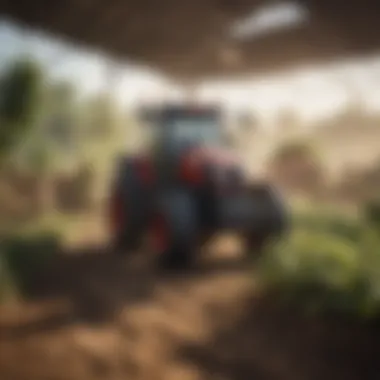Unveiling the Intriguing Convergence of Agriculture and Gaming Worlds


Game Reviews
Agriculture and gaming form a unique fusion that transcends traditional entertainment boundaries. As we delve into the realm where virtual farming meets gamification, the landscape shifts to unveil a tapestry of innovation and learning opportunities. Virtual farming simulations serve as the cornerstone of this convergence, offering a blend of entertainment and educational experiences. By exploring the gameplay mechanics and features embedded within these agro-gaming environments, players embark on a journey that combines the art of cultivation with the thrill of digital interaction. Graphic interfaces and sound quality further elevate the immersive experience, painting a vivid picture of agrarian landscapes. However, like all creations, these agriculture games present both advantages and drawbacks, paving the way for a thorough analysis of their merits and shortcomings.
Tips and Strategies
Diving into the world of agriculture games requires a nuanced approach, catering to gamers of all skill levels. For beginners venturing into the realm of virtual farming, essential tips are indispensable. These foundational pieces of advice serve as guiding lights, illuminating the path to successful harvests and efficient resource management. On the flip side, seasoned gamers seek advanced strategies to challenge their skills and unlock hidden secrets within the game's framework. From uncovering elusive Easter eggs to staying abreast of updates and patches, a comprehensive understanding of the game is essential for players looking to master the art of agricultural gaming.
Device Reviews
In tandem with the gaming experience, a crucial component lies in the devices that fuel these virtual agricultural pursuits. Specifications and features of these devices play a pivotal role in determining the seamless execution of gameplay. Performance metrics and battery life assessments become critical factors in assessing the longevity of gaming sessions. Comparative analysis with similar devices sheds light on the competitive landscape, allowing players to make informed decisions on their hardware choices. Balancing the cost implications with the value for money ratio forms the cornerstone of device reviews within the agriculture gaming sphere.
How-to Guides
A comprehensive guide to agricultural gaming is incomplete without practical how-to resources for players navigating the virtual fields. Step-by-step tutorials unravel the complexities of game objectives, offering a structured approach to achieving in-game milestones. Troubleshooting common issues and errors provides players with the necessary support to overcome technical hurdles and glitches seamlessly. Optimization tips further enhance the gaming experience, ensuring smooth gameplay and maximizing device capabilities. Community engagement strategies round off the how-to guides, fostering a sense of camaraderie among players and encouraging collaborative interactions within the agriculture gaming community.
Introduction
Agriculture games, a unique realm where virtual crops sway in the digital breeze, have garnered attention in the gaming sphere. This article embarks on a journey to dissect the fusion of agriculture and games, unraveling the intricacies of this emerging trend. From fostering entertainment to cultivating educational opportunities, the blend of farming simulations with gamification unveils a playground where learning meets leisure.
Understanding the Concept of Agriculture Games
Evolution of Agriculture Games
The evolution of agriculture games traces back to the roots of gaming history, mirroring the progression of technology and societal interests. These games have transitioned from simple pixelated farms to immersive, realistic farming experiences. The allure of agriculture games lies in their ability to simulate the agricultural world while providing players with a taste of managing a farm. This evolution injects freshness into the gaming landscape, offering a break from traditional gameplay styles, inviting players into a slower, more contemplative gaming experience. Despite some drawbacks like occasional technical glitches, the evolution of agriculture games paints a promising future for gamers seeking a blend of relaxation and strategy.
Benefits of Agriculture Games
The benefits of agriculture games extend beyond entertainment, transcending into the realms of education and skill development. These games offer a unique platform for players to understand agricultural practices without getting their hands dirty. By engaging with virtual crops and livestock, players can grasp the complexities of farming while honing their decision-making skills. The immersive nature of agriculture games fosters empathy towards farmers and their challenges, creating a bridge between urban populations and rural realities. Though not without flaws such as oversimplification of farming processes, the benefits of agriculture games pave the way for a more informed and appreciative society.
Significance of Gamification in Agriculture
Engaging and Educational Aspects
Gamification injects a sense of playfulness and competition into the serious realm of agriculture. By gamifying agricultural practices, developers create engaging platforms where players can learn without feeling the weight of traditional education. This approach not only makes learning fun but also ensures better retention of information. The blend of entertainment with education in agriculture games transforms learning into a journey of exploration and discovery, enriching the minds of players while they cultivate virtual fields. However, the challenge lies in maintaining a balance between entertainment value and educational content to deliver a holistic gaming experience.


Impact on Sustainability Practices
The integration of gamification in agriculture holds immense potential for promoting sustainable farming practices. Through interactive gameplay, players can experiment with eco-friendly farming techniques and understand the importance of sustainable agriculture. These games serve as educational tools, instilling in players the significance of environmental conservation and resource management. By immersing players in scenarios that require sustainable decision-making, gamification in agriculture nudges players towards adopting real-life sustainable practices. Yet, striking a balance between gameplay mechanics and sustainability messaging remains a delicate tightrope walk.
Target Audience for Agriculture Games
Educators and Students
Educators and students form a crucial segment of the audience for agriculture games. These games serve as valuable educational tools for schools and academic institutions, complementing traditional learning methods with interactive experiences. By gamifying agricultural concepts, educators can make lessons more engaging and memorable, catering to diverse learning styles within the student community. However, implementing agriculture games in educational settings requires careful consideration of curriculum alignment and learning outcomes to maximize their educational impact.
Farming Enthusiasts
Farming enthusiasts, ranging from hobbyist gardeners to aspiring farmers, find a welcoming niche in the realm of agriculture games. These games cater to their passion for agriculture, offering virtual spaces to explore different facets of farming without real-world constraints. For enthusiasts looking to expand their agricultural knowledge or simply unwind through virtual farming, agriculture games provide a soothing retreat into the world of cultivation. Nonetheless, developers must ensure that these games strike the right balance between authenticity and entertainment to captivate and retain farming enthusiasts in the digital realm.
Virtual Farming Simulations Introduction
Virtual Farming Simulations play a crucial role in the landscape of agriculture-related gaming. These simulations offer a digital platform for individuals to engage with farming processes and practices in a virtual environment. By immersing players in the virtual farming world, these simulations provide a unique blend of entertainment and education. Players can experience firsthand the challenges and rewards of farming without physical constraints. Through Virtual Farming Simulations, gamers gain insights into agricultural techniques, crop management, and the interplay of various factors affecting farming outcomes.
Simulation Games in Agriculture
Gameplay Mechanics
In Virtual Farming Simulations, Gameplay Mechanics are fundamental components that drive interactions within the game. These mechanics focus on how players navigate the virtual world, make decisions, and accomplish tasks. The key characteristic of Gameplay Mechanics lies in their ability to simulate real agricultural activities effectively. This realism enhances the gaming experience by making it both informative and engaging. The unique feature of Gameplay Mechanics is their adaptability, allowing players to explore different farming scenarios and experiment with various strategies. However, balancing realism with playability can be a challenging aspect of Gameplay Mechanics in Virtual Farming Simulations.
Realism and Accuracy
Realism and Accuracy are essential aspects of Virtual Farming Simulations, contributing to the overall authenticity of the gaming experience. By incorporating realistic elements such as crop growth cycles, weather patterns, and market dynamics, these simulations provide players with a comprehensive understanding of agricultural practices. The key characteristic of Realism and Accuracy is their role in creating an immersive environment that mirrors real-life farming challenges. This authenticity not only educates players about farming concepts but also enables them to make informed decisions within the game. While realism enhances the gameplay by offering a true-to-life experience, maintaining accuracy across all facets of the simulation requires meticulous attention to detail.
Popular Virtual Farming Titles
Farmville
Farmville stands out as a prominent virtual farming title that has captured the attention of gamers worldwide. Its key characteristic lies in its accessibility and user-friendly interface, making it a popular choice for players of all ages. The unique feature of Farmville is its social aspect, allowing players to interact with friends and collaborate on farming activities. While Farmville provides a fun and engaging gaming experience, some players may find its gameplay repetitive over extended periods. Despite this limitation, Farmville continues to attract a dedicated fan base due to its charming visuals and addictive gameplay loop.
Stardew Valley
Stardew Valley offers a more in-depth virtual farming experience, blending farming simulation with role-playing elements. Its key characteristic is the freedom it gives players to explore and manage their virtual farm at their own pace. The unique feature of Stardew Valley is its rich narrative and character interactions, adding layers of depth to the farming gameplay. While Stardew Valley excels in providing a relaxing and immersive farming experience, some players may find its learning curve steep due to the range of activities and choices available. However, this complexity also enhances the game's replay value, keeping players engaged in the long run.


Educational Value of Farming Simulations
Teaching Agricultural Practices
Educational Value The educational value of Farming Simulations lies in their ability to impart practical knowledge about agricultural practices in an interactive format. By simulating real-world farming scenarios, these games enable players to learn about crop cultivation, resource management, and environmental sustainability. The key characteristic of Teaching Agricultural Practices is its hands-on approach, allowing players to experience the complexities of farming firsthand. This experiential learning method enhances understanding and retention of agricultural concepts, making it an effective educational tool. However, the challenge lies in balancing educational content with gameplay elements to ensure an engaging and informative experience for players.
Increasing Awareness
Increasing Awareness through Farming Simulations involves raising consciousness about the significance of agriculture and food production. By highlighting the challenges faced by farmers, the impact of climate change, and the importance of sustainable farming practices, these games promote environmental awareness among players. The key characteristic of Increasing Awareness is its ability to spark dialogue and foster a sense of responsibility towards agriculture and food security. While raising awareness through gaming can be impactful, striking a balance between advocacy and entertainment is crucial to maintaining player engagement. Nevertheless, by leveraging interactive storytelling and gamified learning, Farming Simulations can play a pivotal role in cultivating a generation of environmentally conscious individuals.
Innovative Agro-Gaming Experiences
In the landscape of agriculture and gaming, Innovative Agro-Gaming Experiences stand as a pivotal junction, offering a glimpse into the future of interactive agricultural engagement. The fusion of agriculture and technology in gaming platforms opens doors to a realm where virtuality meets the reality of farming practices. This section delves into the transformative potential of merging agriculture with cutting-edge technology to create immersive and educational experiences. By blending traditional farming methods with modern gaming interfaces, Innovative Agro-Gaming Experiences cater to a wide audience curious about sustainable agriculture and technological advancements.
Merge of Agriculture and Technology
Augmented Reality Applications
Augmented Reality (AR) Applications represent a groundbreaking leap in the journey of agriculture games, bringing a layer of digital information overlay to the physical world. In the realm of this article, AR Applications redefine how players interact with agricultural concepts by superimposing virtual elements onto real-world environments. The key characteristic of AR Applications lies in their ability to provide a multi-sensory experience, enhancing user engagement and knowledge retention. Their unique feature of blending virtual objects seamlessly with the surroundings offers players an unparalleled level of immersion. While the advantages of AR Applications in this context include enhancing learning outcomes and promoting interactive experiences, some considerations involve the need for compatible devices and potential data privacy concerns.
Farming Simulator Accessories
Farming Simulator Accessories play a crucial role in enhancing the authenticity and depth of virtual farming simulations, contributing significantly to the overarching goal of merging agriculture with gaming. These accessories serve as tangible interfaces that simulate real-world farming tools and machinery, offering players a hands-on experience of agricultural operations. Their key characteristic lies in their ability to bridge the gap between virtual gameplay and physical engagement, providing a more encompassing sensory experience. The unique feature of Farming Simulator Accessories is their capacity to amplify players' understanding of complex farming tasks through tactile feedback and realistic interaction. While the benefits of these accessories include increased immersion and learning effectiveness, challenges such as cost and accessibility may pose limitations in certain gaming environments.
Hands-On Learning Through Games
Interactive Planting Simulators
Interactive Planting Simulators represent a fundamental aspect of hands-on learning in agriculture games, offering players a virtual platform to engage with the intricacies of planting and cultivation. Within the scope of this article, these simulations immerse players in realistic planting scenarios, where they can experiment with different crops and techniques without physical constraints. The key characteristic of Interactive Planting Simulators is their interactive nature, allowing players to make informed decisions and observe the outcomes of their choices. Their unique feature lies in providing a risk-free environment for players to learn about planting practices and agricultural management. While the advantages of these simulators include fostering decision-making skills and crop knowledge, potential disadvantages may relate to the limitations of virtual representation compared to real-life farming scenarios.
Crop Management Challenges
Crop Management Challenges present players with a series of strategic decisions and obstacles to overcome, reflecting the complexities of real-world agricultural management. In the context of this article, these challenges offer a dynamic and engaging gameplay experience where players must navigate through issues such as pest control, crop diseases, and weather fluctuations. The key characteristic of Crop Management Challenges is their focus on critical thinking and problem-solving skills, providing players with a holistic view of the challenges faced by farmers. Their unique feature lies in instilling a sense of responsibility and accountability in players towards virtual crop outcomes. While the advantages of these challenges include promoting strategic planning and risk assessment, potential disadvantages may include the need for continuous updates to maintain relevance and accuracy.
Challenges and Opportunities in Agriculture Games


In this section, we will dissect the intricate landscape of challenges and opportunities present in the realm of Agriculture Games. The juxtaposition of traditional agriculture practices with modern gaming technologies brings forth a unique set of hurdles and prospects that demand exploration.
Technological Limitations
Integration with IoT
Integration with the Internet of Things (Io T) stands as a pivotal aspect in harnessing the full potential of Agriculture Games. This integration involves connecting various agricultural devices and systems to a centralized digital network, enabling real-time data monitoring and decision-making. The essence of interoperability is a key characteristic of IoT integration, facilitating seamless communication between diverse agricultural components. This synergy between IoT and Agriculture Games bolsters efficiency, productivity, and sustainability. Despite its advantages, challenges such as data security vulnerabilities and interoperability issues persist, making it imperative for developers to navigate these complexities adeptly.
Data Accuracy Concerns
Data accuracy is a cornerstone concern that significantly influences the efficacy of Agriculture Games. Ensuring the precision and reliability of data input and output within these gaming platforms is critical for facilitating informed decision-making and realistic simulation experiences. The meticulous validation and verification of data sources and algorithms are fundamental for upholding the integrity of agricultural simulations. However, data accuracy concerns also encompass issues like data bias, incomplete datasets, and adequacy of data contextualization. Striking a balance between data granularity and performance optimization is crucial in addressing these concerns effectively.
Potential for Industry Growth
Collaborations with Agricultural Experts
The realm of Agriculture Games presents a fertile ground for collaborations between game developers and agricultural experts. Leveraging the specialized knowledge and insights of agricultural professionals can enrich the educational and experiential aspects of these gaming experiences. The integration of real-world agricultural practices, expertise, and challenges into gaming scenarios adds a layer of authenticity and relevance that resonates with players. Collaborations with agricultural experts not only enhance the educational value of Agriculture Games but also open avenues for presenting innovative solutions to contemporary agricultural issues.
Market Expansion Strategies
Navigating the dynamic landscape of the gaming industry requires robust market expansion strategies tailored to the unique characteristics of Agriculture Games. Embracing targeted marketing campaigns, strategic partnerships with agribusinesses, and utilizing data-driven insights are instrumental in expanding the reach and impact of these specialized games. Moreover, exploring diverse distribution channels, including online platforms and specialized agricultural exhibitions, can enhance the visibility and accessibility of Agriculture Games to diverse audiences. However, challenges such as market saturation and competition with mainstream gaming genres necessitate agile and creative approaches to sustainable market expansion.
Future Trends and Predictions
The section on Future Trends and Predictions is crucial in this comprehensive exploration of the intersection of Agriculture and Games. It sheds light on the trajectory that agriculture games are poised to take in the near future. By discussing emerging technologies, the article provides valuable insights into what gamers and enthusiasts can anticipate in the realm of agro-gaming. Understanding these trends is vital for those interested in the continual evolution of this niche segment. Predictions offer a glimpse into the direction in which agriculture games are headed, influencing game development, player experiences, and industry standards. Observing trends can help stakeholders adjust strategies, capitalize on opportunities, and remain at the forefront of innovation in the agriculture gaming space.
Emerging Technologies in Agro-Gaming
Blockchain Applications
Delving into Blockchain Applications, we uncover a revolutionary aspect of technology that deeply impacts agriculture gaming. Blockchain's decentralized nature and secure architecture play a pivotal role in areas such as in-game transactions, asset ownership, and data management. The inherent transparency and immutability of blockchain make it a highly favorable choice for enhancing trust and security within agriculture games. Its unique feature lies in creating tamper-proof records of transactions, ensuring integrity and accountability in gaming environments. While blockchain offers enhanced security and efficiency, potential challenges include scalability issues and complexity in implementation, which developers need to navigate for optimal integration with agriculture games.
VR Integration
Exploring VR Integration unveils an immersive facet that enriches the overall experience of agro-gaming. Virtual Reality's key characteristic lies in its ability to transport players into realistic agricultural settings, enabling a heightened sense of engagement and presence. The popularity of VR in agriculture games stems from its capacity to offer a more interactive and sensory-rich gameplay environment, enhancing learning and entertainment aspects. The unique feature of VR lies in its capacity to simulate diverse agricultural scenarios with unparalleled realism, providing players with an immersive and educational journey through various farming activities. However, challenges such as hardware requirements and potential motion sickness issues necessitate careful consideration for optimal VR integration in agriculture gaming platforms.
Shift Towards Sustainable Gaming Practices
In addressing the Shift Towards Sustainable Gaming Practices, the article emphasizes the growing importance of environmental and social considerations within agro-gaming. Environmental Awareness Campaigns play a critical role in disseminating key sustainability messages to players, encouraging eco-friendly practices, and raising awareness about agricultural impact on the environment. The key characteristic of such campaigns is their ability to foster a sense of responsibility and stewardship among gamers, promoting real-life behavioral changes and ecological mindfulness. While advantageous in promoting environmental consciousness, challenges such as balancing educational content with engaging gameplay mechanics need to be carefully navigated for effective integration of environmental awareness themes in agriculture games.
Social Impact Initiatives
Delving into Social Impact Initiatives unveils a transformative aspect that amplifies the positive influence of agro-gaming on society. The key characteristic of social impact initiatives lies in their capacity to leverage gaming as a platform for social good, promoting charitable causes, community engagement, and humanitarian efforts. By integrating elements of social responsibility and inclusivity, such initiatives contribute to creating a more socially conscious and empathetic gaming environment. The unique feature of social impact initiatives is their ability to harness the collective power of gamers for meaningful change, fostering a sense of community and cooperation beyond the virtual realm. While offering immense benefits in promoting social causes, challenges related to campaign sustainability and impact measurement necessitate a strategic approach in implementing social impact initiatives within agriculture games.

